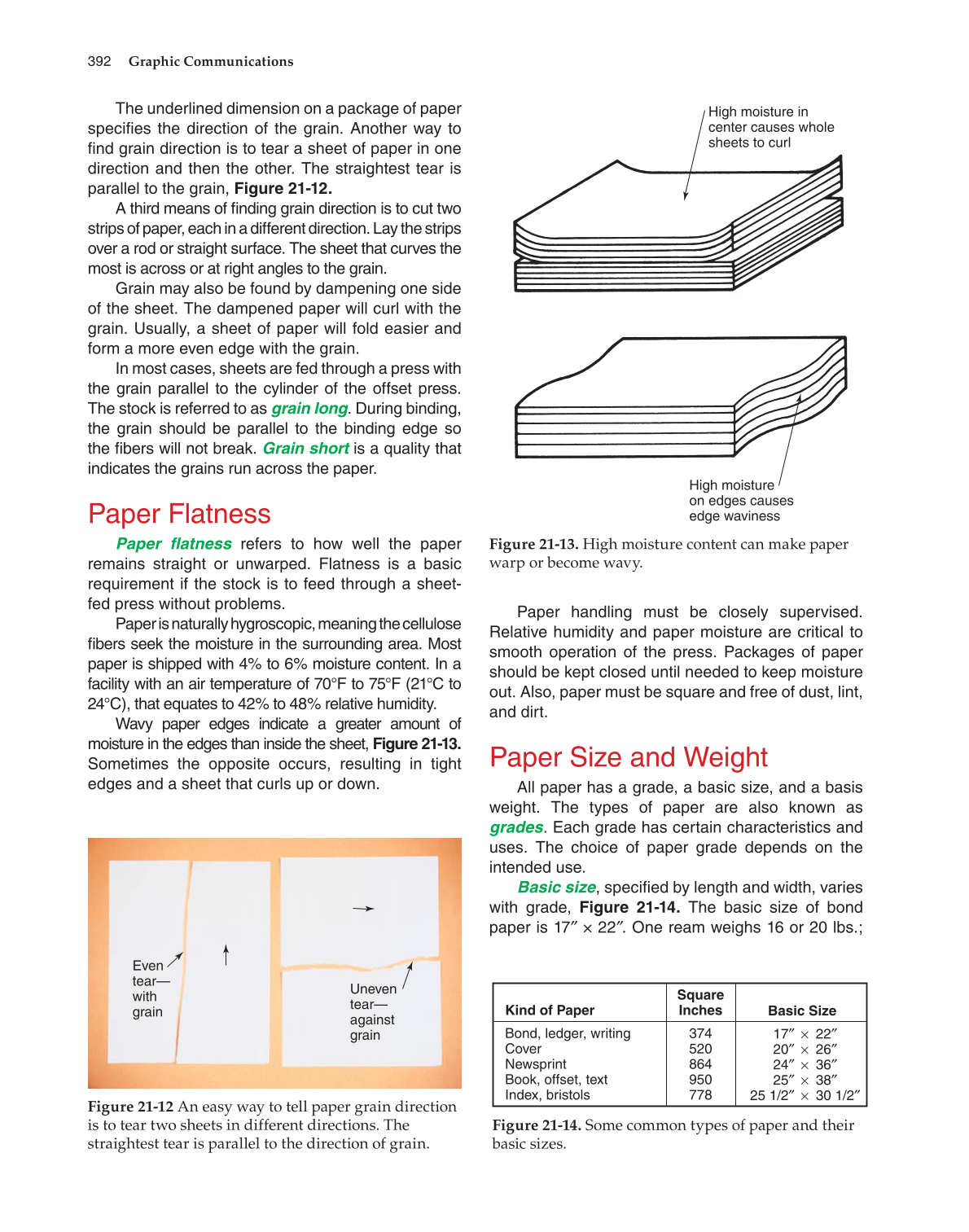392 Graphic Communications
The underlined dimension on a package of paper
specifi es the direction of the grain. Another way to
fi nd grain direction is to tear a sheet of paper in one
direction and then the other. The straightest tear is
parallel to the grain, Figure 21-12.
A third means of fi nding grain direction is to cut two
strips of paper, each in a different direction. Lay the strips
over a rod or straight surface. The sheet that curves the
most is across or at right angles to the grain.
Grain may also be found by dampening one side
of the sheet. The dampened paper will curl with the
grain. Usually, a sheet of paper will fold easier and
form a more even edge with the grain.
In most cases, sheets are fed through a press with
the grain parallel to the cylinder of the offset press.
The stock is referred to as grain long. During binding,
the grain should be parallel to the binding edge so
the fi bers will not break. Grain short is a quality that
indicates the grains run across the paper.
Paper Flatness
Paper fl atness refers to how well the paper
remains straight or unwarped. Flatness is a basic
requirement if the stock is to feed through a sheet-
fed press without problems.
Paper is naturally hygroscopic, meaning the cellulose
fi bers seek the moisture in the surrounding area. Most
paper is shipped with 4% to 6% moisture content. In a
facility with an air temperature of 70°F to 75°F (21°C to
24°C), that equates to 42% to 48% relative humidity.
Wavy paper edges indicate a greater amount of
moisture in the edges than inside the sheet, Figure 21-13.
Sometimes the opposite occurs, resulting in tight
edges and a sheet that curls up or down.
Paper handling must be closely supervised.
Relative humidity and paper moisture are critical to
smooth operation of the press. Packages of paper
should be kept closed until needed to keep moisture
out. Also, paper must be square and free of dust, lint,
and dirt.
Paper Size and Weight
All paper has a grade, a basic size, and a basis
weight. The types of paper are also known as
grades. Each grade has certain characteristics and
uses. The choice of paper grade depends on the
intended use.
Basic size, specifi ed by length and width, varies
with grade, Figure 21-14. The basic size of bond
paper is 17″ × 22″. One ream weighs 16 or 20 lbs.;
Uneven
tear—
against
grain
Even
tear—
with
grain
Figure 21-12 An easy way to tell paper grain direction
is to tear two sheets in different directions. The
straightest tear is parallel to the direction of grain.
High moisture in
center causes whole
sheets to curl
High moisture
on edges causes
edge waviness
Figure 21-13. High moisture content can make paper
warp or become wavy.
Kind of Paper
Bond, ledger, writing
Cover
Newsprint
Book, offset, text
Index, bristols
Square
Inches
374
520
864
950
778
Basic Size
17″ × 22″
20″ × 26″
24″ × 36″
25″ × 38″
25 1/2″ × 30 1/2″
Figure 21-14. Some common types of paper and their
basic sizes.
